How 'good news' stories hide healthcare woes
- Published
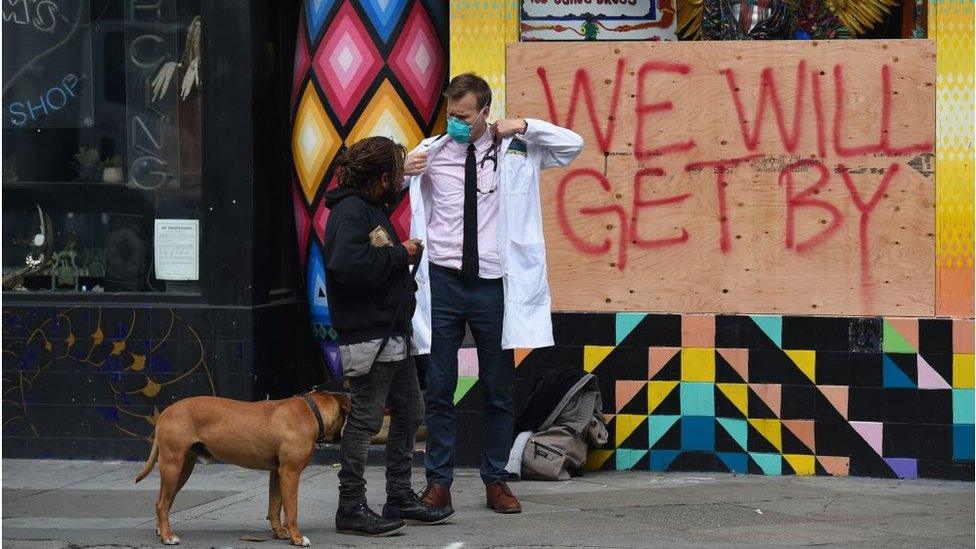
A doctor in San Francisco speaks to homeless people about their health
US headlines abound of average Americans crowd sourcing funds for their medical treatment, or selflessly forgoing necessary medicine in order to save money for their families. Why are these stories so popular?
Dillon Hooley was a 17-year-old high school senior when he began cutting back on insulin, a life-saving drug necessary to manage his diabetes. The decision nearly caused him to die in his sleep.
"I wasn't thinking right, but my parents work so hard to give me what I need, and I didn't want to put more financial stress on them," he told CNN in a 2019 article about the skyrocketing costs of insulin.
The family's insurance deductible required them to spend $5,500 (£4,000) before receiving any benefits, forcing them to pay $800 per month for Dillon's insulin. The coverage was provided by his father's job at a steel mill in Utah.
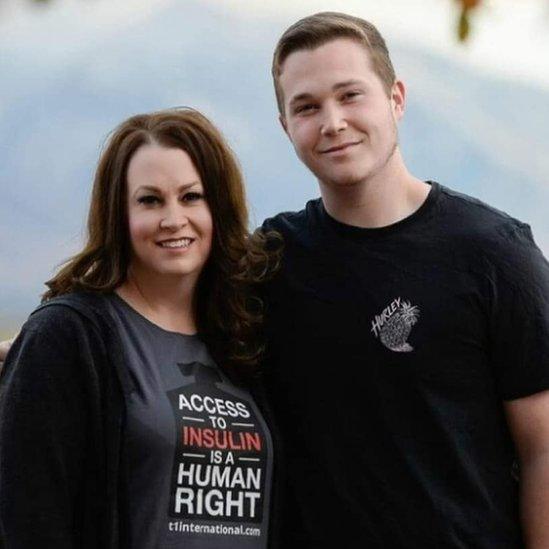
Mindie Hoolie and her son Dillon

Cutting back his dosage to life-threatening levels was an illustration of how the teen "wanted to help out any way he could," said the article's introduction, external.
"My son really didn't like the CNN story and how he was portrayed," says his mother, Mindie Hooley, who saved his life by waking him up and bringing him to hospital after he almost slipped into a coma due to a lack of insulin in his blood.
"The story made him seem like a 'hero' who rationed his insulin to save his family and this wasn't the case at all. He felt he had no other choice other than to ration," she says, describing how the family had suffered financially.
"Our family wishes that the article would have emphasised more about why he felt he had to ration. We wish that the emphasis was on why so many are to blame for why insulin is so expensive," Mrs Hooley told the BBC.
Manufacturers have raised costs sky high in order to give steep discounts to middlemen acting on behalf of insurance companies, says Mrs Hooley, who now advocates for affordable insulin access with the group T1International.
The family's insurance company does not pay for Dillon's continuous glucose monitor, test strips, or other supplies, also costing him thousands of dollars each month. To save money, he orders insulin through an online pharmacist, leading to batches that sometimes arrive late or spoiled.
Now 20, Dillon has gone to work at the same company as his father, doing 12-hour graveyard shifts to earn enough money to fill in the gaps that health insurance will not cover.
Dillon's story of medical financial struggle being painted as a positive is not unique. Critics say it misses the point - but some say it can be life-saving if the appeal resonates.
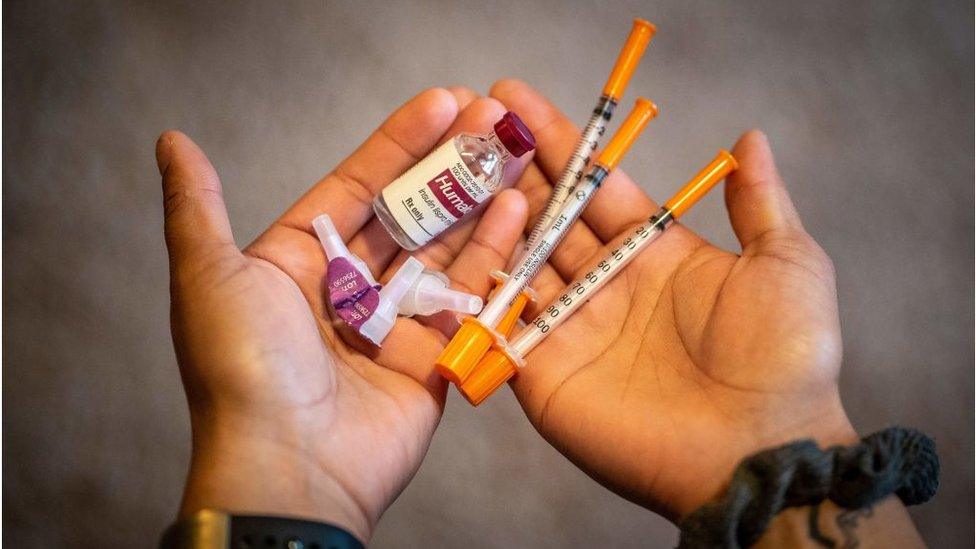
Diabetic Americans sometimes turn to the black market for insulin
Researcher Alan MacLeod refers to these types of stories, depicting triumph over adversity, as "perseverance porn".
MacLeod, who is based in Scotland and represents the group Fairness and Accuracy in Reporting, says stories of working-class people persevering against all odds have been told throughout history, and speak to the public's desire for human interest stories that put their own lives into perspective.
"These sorts of stories about persevering through tough times are really sort of relevant to pretty much anyone," he says, adding that they are growing in popularity as people struggle amid the global pandemic.
'I hope I make it'
The story of a seven-year-old girl from Birmingham, Alabama, selling lemonade to fund her brain surgeries went viral earlier this year.
Liza Scott's appeal raised nearly $400,000 (£290,000), allowing her to fly to Boston for a series of potentially life-saving operations.
Her mother, Elizabeth Scott told the BBC in an email that "it's amazing that [her story] has reached folks around the world".
MacLeod says that "kids selling lemonade are a classic example" of the "perseverance porn" that he has documented, external.
He has seen several cases of children setting up lemonade stands to pay for their parents' or their own medical treatment.
"It's never truly acknowledged that if these children lived in a more humane society, their perseverance would not even be necessary."
"If that girl lived in Nova Scotia, Norway or New Zealand she wouldn't have to desperately try to sell lemonade on the street to afford her medical bills."
Crowd-sourcing website GoFundMe says that at least one third of its fundraisers are for medical treatments. Healthcare costs are also the leading cause of bankruptcy in the US.
'My TikTok fans saved my life'
Quiiroi Ramos is a type-one diabetic with multiple chronic illnesses who uses TikTok to spread awareness about disabilities - and stay alive.
Whenever Ramos has been kicked off private insurance, which has happened repeatedly and for varied reasons, the 21-year-old jewellery designer has relied on TikTok followers to help pay for insulin.
"If it wasn't for the fact that I had a really large TikTok following, I would have been dead. Because nobody would have seen that GoFundMe," Ramos tells BBC News.
Ramos identifies as two-spirited, a third gender in Native American tradition, and uses they/them pronouns.
They have around 60,000 followers under the name @quiibunnie, and says that being a "failure of the foster system" is the most recent reason that they lost their healthcare coverage.

Quiiroi Ramos relies on GoFundMe for medications

Ramos' non-biological parents, who raised them since they were 17 months old, did not ever legally adopt them despite being their legal guardians.
For that reason, the family's insurance company decided that Ramos is not considered a dependent - not actually their child - and must purchase a separate coverage plan.
Ramos, who uses a wheelchair, now pays about $375 per month to the insurance company, and still has to pay another $700 per month for medications. That is still cheaper than buying the insulin without any insurance.
After their most recent fundraising campaign, the third they've been forced to do, Ramos felt pressured to lie and tell their followers: "It's okay, guys. I'm fine."
"My story got shared around on TikTok and people had been asking for a positive update on the story, and I wish I could give them a positive update on the story, but I really can't," Ramos says.
"Because I'm still definitely struggling incredibly financially," they continue, adding that diabetes will probably cause further health problems in their future.
"I don't know if I'm going to be able to tell my platform, like, 'Oh this will never happen again. I'll never need your help again'."
"But the reality of the situation is I will. I will always need help again," Ramos says, adding that "the reality of medical care in America is you have money or you die."
"I am exhausted from trying to get people on the internet to care enough about my life to donate five dollars," says Ramos.
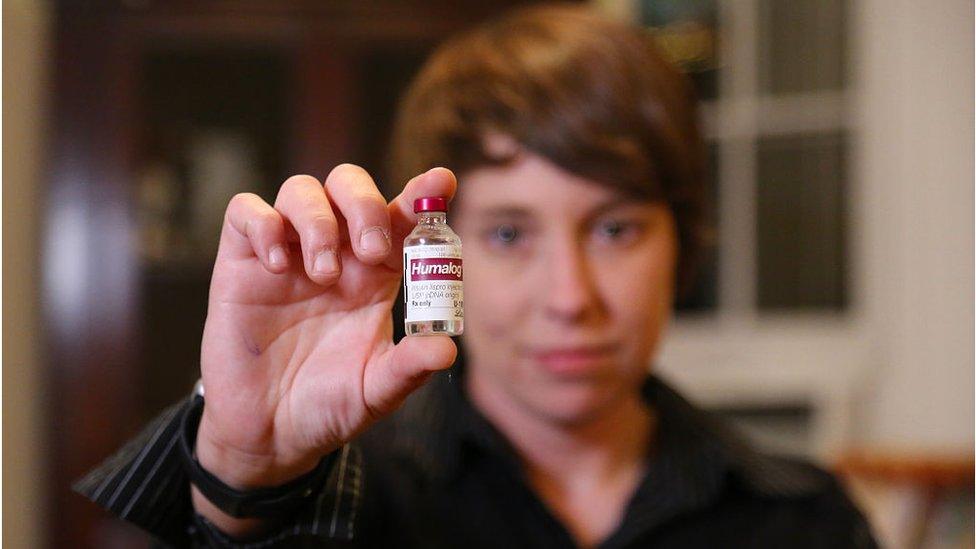
Laura Marston shows the insulin she needs to live
Laura Marston says that stories of diabetic Americans losing their insulin access or being forced to ration the life-saving medicine are extremely common across the country.
"If you really think down to the bare bones of the concept of paying for insulin, its very akin to this: If three companies own all of the world's oxygen and every breath you needed you had to pay for," says Marston, who is also diabetic.
The 38-year-old IT lawyer lost her own health insurance after her employer died expectantly and the law firm where she started her career was dissolved.
"It always kind of baffles me that people who are dealt a genetic hand - in this country at least - are told to work harder and make more money to pay not just the cost of our medical care but to prop up the industries like pharma," she says.
'This is awesome!'
Even for families with employer-provided health insurance, the benefits may not sufficiently provide for the medical need, and the system often seems designed to be as confusing as possible.
When two-year-old Logan Moore's medical condition made it impossible for him to walk, his family decided that the boy couldn't wait for a needed medical device to be approved by the family's insurance provider.
So they did it themselves.
One afternoon in 2019, Logan and his mum went to Home Depot hardware store in Georgia and asked where to find the parts they would need to build a walker, which they had researched how to make themselves on YouTube.
Instead, the employees told the family to get some ice cream while they assembled a personalised walker for Logan on the company's dime.
Allow X content?
This article contains content provided by X. We ask for your permission before anything is loaded, as they may be using cookies and other technologies. You may want to read X’s cookie policy, external and privacy policy, external before accepting. To view this content choose ‘accept and continue’.

The image of young Logan was widely shared online, but many found the story to be heartbreaking and "dystopian".
"This is awesome!" tweeted a Fox TV affiliate in Washington DC, alongside a picture of the smiling boy.
"This is horrific," one person responded.
"This isn't heart-warming. It's an indictment of the US healthcare system," replied another.
"Regular people being lovely, generous, and creative is good. Making marginalised people depend on them for basic survival is not," tweeted another user.

You may also be interested in:
Bullets and bills: The cost of getting shot in America
- Published14 March 2019
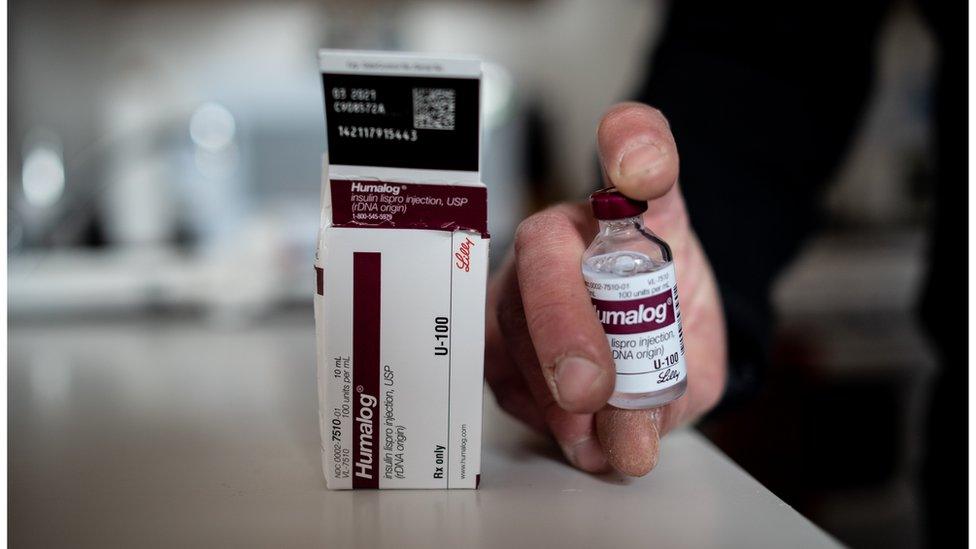
- Published15 August 2019
